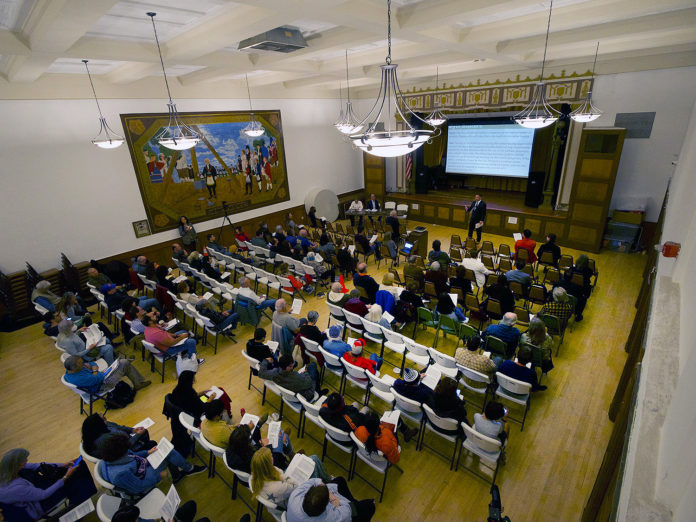
With debate over the future of the Caltrans-owned homes in South Pasadena heating up, the City on Thursday held a major “community meeting” in an effort to clear the air and clarify the City’s plans under SB 381, the city-sponsored legislation under which it is pursuing a final disposition for the 68 properties. The meeting was held at South Pasadena Masonic Lodge Auditorium. City officials said 105 people attended the meeting.
So far, Caltrans has offered to sell to the City 20 unoccupied properties. The City is currently working to complete inspections in advance of receiving formal sale and purchase agreements from Caltrans. The City intends to turn any properties it purchases over to its own or another “housing-related entity” or land trust to rent or sell to buyers.
To date, nothing’s been signed.
The emotionally volatile nature of the topic was immediately on display in opening remarks by Deputy City Manager Domenica Megerdichian, who laid down strict ground rules for the meeting, sought to “dispel rumors” about imminent evictions, emphasized that all policy decisions will be made in public settings, debunked “conspiracy theories” about why the meeting was not being held at city hall, and asserting that the City “has not partnered with any senior living, halfway house, transitional housing, post-prison, homeless shelter or any other provider” to take custody of the properties.
District 2 South Pasadena City Council Member Jack Donovan, who along with Mayor Pro Tem Jon Primuth chairs the Council’s SB 381 Implementation ad hoc committee, noted the meeting featured a slew of “heavy hitters,” including himself and Primuth; Caltrans Deputy District Right of Way Director Ed Francis and members of his staff; representatives from the offices of County Supervisor Kathryn Barger, Assemblymember Mike Fong, Assemblymember Chris Holden and Senator Portantino, who filed and oversaw passage of SB 381 on behalf of the city; City Manager Arminé Chaparyan and her staff, and others.
“This meeting is to answer a lot of questions that have come up and to put to bed some misinformation” and other “myths” that are also out there, Donovan said during both a city council meeting the day before and during the Masonic Lodge session, noting he’s gotten 100 emails on the matter over the last six weeks. “We are getting down to nuts and bolts and want to…present what we have. We want to hear from you, answer your questions and give you the right answers to the questions.”
During Wednesday’s council meeting, a unanimous vote was taken to increase the City’s contract with CivicStone, its Caltrans housing consultant, by $25,000 to $105,859 so that it can continue its work evaluating the City’s plan to purchase and then dispose of the Caltrans properties in a manner acceptable to the city.
Primuth emphasized the complexity of the situation and said the contract increase will help better lay out the risks and costs the City faces in pursuing its strategy to buy the 20 vacant properties. But while noting opposition to the City’s plan, he again stated the City is also considering an alternative plan offered by the South Pasadena Preservation Foundation (SPPF), as well as other comments Council has received. “But he said he is increasingly skeptical of SPPF’s approach, which involves the use of “double” or “side-by-side” escrows.
“We don’t want to foreclose anything,” but it is a complex situation, Primuth said, with Caltrans on separate tracks for the sale of the first tranche of 20 unoccupied properties to the City; bilateral negotiations between Caltrans and the tenants of occupied properties; a separate process for historic houses; and a second tranche of unoccupied properties to be offered later by Caltrans to the City.
Most unappreciated, he said, is that while some may oppose the city’s acquisition of the unoccupied houses, those not purchased by the City will by law be offered to the County of Los Angeles, an outcome he said no one on the council wants.
“We are exploring all the options but have some constraints,” he emphasized. For the moment, the council still “has every policy decision ahead of it,” except that it will not allow the homes to be sold to the county.
City Caltrans housing subconsultant Grant Henninger provided a detailed timeline of events going forward, emphasizing the many policy decisions yet to be made, such as: whether or not to sell all the homes to single entity; whether the City will do any rehabilitation work or sell them “as is” (the rehab costs are still being assessed by a city inspection firm); whether to sell the homes to an affordable housing developer—of which there is wide range, both good and bad–or to a community land trust managed by a locally-appointed board, which would in turn decide whether to offer them as “affordable” properties for sale or rent; and to determine the “affordability” of the 20 houses–seven of which are historic properties–as SB 381 requires they be made available to lower income owners or tenants.
During the remaining 75 minutes, the panel took on questions and comments from the audience about multiple issues, including: the break-ins and unauthorized occupation of the vacant homes; the status of bilateral sales between Caltrans and residents of occupied properties; whether the properties can be counted toward the city’s share of the state-mandated regional housing needs allocation (they can’t); the particulars of what income levels qualify as “affordable”; how many of the homes are actually “historic”; and questions over the details and viability of SPPF’s “double escrow” alternative approach.
Responding to statements reflecting the intense frustration and exasperation tenants have experienced over Caltrans’ decades of mismanagement of the properties, compounded by years of bureaucratic obstinacy in its mercurial on again, off again sales processes, Caltrans’ Francis said he was listening and taking notes. “I know there is a lot of skepticism. I can’t undo what has happened before,” he allowed. “We are moving forward. The process is happening. I give you my word.”
The meeting comes as tensions have risen between supporters of the plan submitted by SPPF and those who oppose it, led by CareFirst and the South Pasadena Tenants Union. Fundamentally, opponents object to what they see as SPPF’s and the City’s attempt to steer the homes into private hands instead of using them to expand low-income housing opportunities.
But the rhetoric has gotten hotter. “The decision to sell Caltrans houses to private buyers privileges single-family houses,” according to a CareFirst social media post. “It is part of a long-held pattern in affluent enclaves that locks out low-income and people of color and exacerbates the region’s housing crisis.”
At Wednesday’s council meeting and in social media posts, CareFirst supporter Ella Hushagen, an attorney and city commissioner, said there is a “precedent” for SPPF’s effort from 80 years ago when, during World War II, about 165 Japanese residents were forcibly relocated to camps. Citizens at a Chamber of Commerce meeting were concerned the vacated homes would be overtaken by “undesirables” and so wanted to upgrade the homes to make them unaffordable to “colored people from Pasadena,” she reported, citing material in the City’s draft housing element.
(For what it’s worth, the housing element goes on to note that then Mayor Andrew O. Porter responded saying “The city cannot exercise any control over these properties,” as responsibility of any improvements would lie with the owners.)
“I’m not saying anybody went to closed session and made overtly racist statements like in 1942,” Hushagen said. “I am saying that when you act to block affordable housing in South Pasadena, where the median home costs $1.5 million and rent is on average $800 more than in the county, you exclude Black and Latinx people.”
CareFirst has also criticized the City’s lawsuit to prevent the sale of a 12-unit Caltrans property at 626 Prospect to a historic Black church in Pasadena that wants it to develop affordable housing.
SPPF and the City have both noted that under SB 381, for every unoccupied historic home acquired, the city must create three affordable units. While the City can use the proceeds from the sales of the seven historic homes — preliminary estimated at over $9 million — to promote affordable housing development, those proceeds will likely be reduced by multiple factors including unknown property rehabilitation and security costs, as well as tax roll losses due to the assignment of the properties to nonprofit entities.
SPPF says under its plan, use of the double escrows would generate an estimated $20 million surplus from market sales that could be allocated to affordable unit development under any of the City’s multiple housing programs, while keeping the property on tax rolls.
CareFirst also believes the funds generated under the SPPF plan would be insufficient to develop the number of units required under SB 381. SPPF, noting its plan generates more funding for affordable housing than under SB 381, also points out the funds generated under its plan can be used as “a force multiplier” to leverage even more funds that could be used for affordable housing from other sources such as grants.
As to the racial overtones of CareFirst’s critique, SPPF did not offer a formal reply. But former South Pasadena Mayor Odom Stamps, a past SPPF president, said “the sale of the Caltrans surplus properties represents a tremendous opportunity to turn what had been a blighting influence on the community into a future that includes restored and safe housing that is affordable to the full spectrum of income levels.”
He noted that the all-volunteer SPPF has “devoted thousands of hours over the decades to stop the 710 freeway and ensure the return of our South Pasadena homes back to our neighborhoods.” He asserted there are “many options available to make this happen,” including that under the Roberti Bill, which has a process “that most people involved agree is reasonable and fair.”
“The idea of simply selling off South Pasadena properties quickly to outside HRE corporations defeats the very purpose of maintaining our small community town environment, and simultaneously gives away the say-so of all of us as residents of the homes–rentals or otherwise.”
CalTrans Homes South Pasadena | Special Community Meeting Nov. 3, 2022
Please ‘like’ and ‘subscribe’ when viewing on YouTube.















.png)










